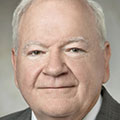
This webinar took place on May 7, 2014
Recorded version for on-demand viewing (Requires Windows Media Player 9 or higher to view)
Webinar Presentation Slides
This webinar took place on May 7, 2014
Recorded version for on-demand viewing (Requires Windows Media Player 9 or higher to view)
Webinar Presentation Slides
- Webinar PDF Archive (Registration required)
As with many technology-rich challenges, solving the technical questions of designing unmanned aircraft systems (UAS) is just a piece of the puzzle facing the U.S. Federal Aviation Administration (FAA): how to integrate UAS into the National Airspace System (NAS).
Chuck Johnson, NASA’s senior advisor for UAS, Elizabeth Soltys, the FAA’s manager of UAS Test Site Selection, and Ro Bailey and Jon Greene, leaders of two of those UAS test site organizations explored the question in a 90-minute technical webinar on May 7.
As with many technology-rich challenges, solving the technical questions of designing unmanned aircraft systems (UAS) is just a piece of the puzzle facing the U.S. Federal Aviation Administration (FAA): how to integrate UAS into the National Airspace System (NAS).
Figuring out the equipment standards, flight and air traffic control procedures, and associated policies will take longer and involve far more collaboration, research, and evaluation. Recently, the FAA named six test site organizations to help the agency fill in the information gaps in its UAS in the NAS initiative.
Trimble sponsored the event.
Panelists
 Charles W. (Chuck) Johnson is NASA’s senior advisor for unmanned and autonomous systems for the National Aeronautics and Space Administration (NASA), where he is responsible for developing the overall strategy for all unmanned systems – from remotely piloted to fully autonomous. Prior to this position, from 2010 to 2013 Johnson was the project manager for the Unmanned Aircraft System (UAS) in the National Airspace System (NAS) Project. There he was responsible for execution of a $160-million technology development project to reduce technical barriers related to safety and operational challenges associated with enabling routine UAS access to the NAS. Johnson began his aviation career at the Federal Aviation Administration in 1982. He earned a B.A. degree in psychology from the University of Colorado and an MBA from San Diego State University.
Charles W. (Chuck) Johnson is NASA’s senior advisor for unmanned and autonomous systems for the National Aeronautics and Space Administration (NASA), where he is responsible for developing the overall strategy for all unmanned systems – from remotely piloted to fully autonomous. Prior to this position, from 2010 to 2013 Johnson was the project manager for the Unmanned Aircraft System (UAS) in the National Airspace System (NAS) Project. There he was responsible for execution of a $160-million technology development project to reduce technical barriers related to safety and operational challenges associated with enabling routine UAS access to the NAS. Johnson began his aviation career at the Federal Aviation Administration in 1982. He earned a B.A. degree in psychology from the University of Colorado and an MBA from San Diego State University.
 Elizabeth Soltys, manager of the FAA’s UAS Test Site Program, began her federal career designing air-traffic control facilities to house research and full-scale development systems. She has represented FAA in managing inter-agency agreements with NASA and the Department of Defense in order to coordinate cross-agency research portfolios. Soltys also managed a portfolio of contracts with an estimated value of about $6.4 billion over 10 years that supports research and system engineering required for the Next Generation Air Transportation System.
Elizabeth Soltys, manager of the FAA’s UAS Test Site Program, began her federal career designing air-traffic control facilities to house research and full-scale development systems. She has represented FAA in managing inter-agency agreements with NASA and the Department of Defense in order to coordinate cross-agency research portfolios. Soltys also managed a portfolio of contracts with an estimated value of about $6.4 billion over 10 years that supports research and system engineering required for the Next Generation Air Transportation System.
She worked as a structural engineer designing skyscrapers in Manhattan and was employed by the former Kidder, Peabody & Co., in the mergers and acquisitions department. She has a bachelor’s degree (applied mathematics), a five-year engineering degree with emphasis in structural engineering, and a master’s degree in business administration (accounting and finance).
 Rosanne (Ro) Bailey, USAF Brig. Gen. (Ret.), is the director of the Pan-Pacific UAS Test Range Complex and deputy director of the Alaska Center for Unmanned Aircraft Systems Integration – RDT&E. Among other posts during a lengthy USAF career, Bailey served as the commander, Cheyenne Mountain Operations Center, Cheyenne Mountain Air Force Station, Colorado, where she was responsible for executing the North American Aerospace Defense Command’s integrated tactical warning and attack assessment mission, the U.S. Northern Command’s homeland defense mission, and U.S. Strategic Command’s space and missile warning support. She earned a B.S. degree with honors from Purdue University.
Rosanne (Ro) Bailey, USAF Brig. Gen. (Ret.), is the director of the Pan-Pacific UAS Test Range Complex and deputy director of the Alaska Center for Unmanned Aircraft Systems Integration – RDT&E. Among other posts during a lengthy USAF career, Bailey served as the commander, Cheyenne Mountain Operations Center, Cheyenne Mountain Air Force Station, Colorado, where she was responsible for executing the North American Aerospace Defense Command’s integrated tactical warning and attack assessment mission, the U.S. Northern Command’s homeland defense mission, and U.S. Strategic Command’s space and missile warning support. She earned a B.S. degree with honors from Purdue University.
 Jon Greene is the associate director for strategic planning and development for Virginia Tech’s Institute for Critical Technology and Applied Science (ICTAS). Until recently he also served as the interim director of the Mid-Atlantic Aviation Partnership. He joined Virginia Tech in September 2009 after a successful career in the United States Navy, rising to the rank of Captain and, among other posts, serving as commanding officer of the Naval Surface Warfare Center, Dam Neck Division, Virginia Beach, Virginia. Greene earned a Master of Arts degree in National Security Affairs from the Navy Postgraduate School and a Bachelor of Science in political science from the U.S. Naval Academy.
Jon Greene is the associate director for strategic planning and development for Virginia Tech’s Institute for Critical Technology and Applied Science (ICTAS). Until recently he also served as the interim director of the Mid-Atlantic Aviation Partnership. He joined Virginia Tech in September 2009 after a successful career in the United States Navy, rising to the rank of Captain and, among other posts, serving as commanding officer of the Naval Surface Warfare Center, Dam Neck Division, Virginia Beach, Virginia. Greene earned a Master of Arts degree in National Security Affairs from the Navy Postgraduate School and a Bachelor of Science in political science from the U.S. Naval Academy.







